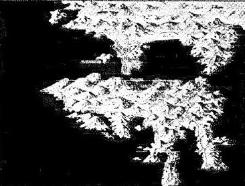| |
From an
interview with Rifleman John Beebe, No.18 Platoon,
The
Royal Rifles of Canada:
"We lost no time in getting
down to work, taking up our posts on guard duty at the permanent
dugouts and shelters. These were our future battle stations and
we got familiar with the lay of the land during our three day
sessions on guard duty. In the following two weeks we got to
know the place even better and to like it very well. We drilled
hard every morning for two or three hours. We had our own rifles
and Brens and although our heavy equipment never arrived, there
was plenty of British heavy equipment and we were well-trained
in its use."
Just In Case
The Canadians set about familiarizing themselves with their
exotic new surroundings. With whatever free time they had, they
visited various sites of interest around Kowloon and the island;
the rest of the time they spent getting to know their battle
stations and the lay of the land.
At first the Canadians were stationed on the mainland. Brigadier
Lawson knew that if war were to come it would not be fought on
the mainland nor come from the sea. He knew Hong Kong Island was
the ultimate objective, and battle ground.There was one man of
authority in Hong Kong who believed the Japanese would attack
sooner than later, and was working very hard to return the
colony to the fortress it once had been. Major General
Christopher M. Maltby was working around the clock to create a
defensive plan that he hoped would deter a Japanese attack, but
he was only one man, and he held fast to one tragically flawed
notion. He believed that the Japanese would attack from the sea
and positioned his troops on the island of Hong Kong
accordingly. As to the mainland, he had another plan.
From the notes of Major Maurice A. Parker, CO "D" Coy Royal
Rifles of Canada, regarding mainland defensive plans which were
made in the event of war before the Canadians arrival:
"The (original) plan of action for the mainland was to employ
the 2/14 Punjabs fighting a rear-guard action astride the main
defiles leading up to the 'Gin Drinkers Line'.They would
demolish fixed sites and equipment, clear vital supplies to the
island, sink shipping in Kowloon Harbour and then, retire to the
island using delaying tactics. This would give the island
defenders more time to prepare for battle. They would disengage
on the mainland with minimal losses as they would be required to
help defend the island."
With the additional Canadian troops, Maltby planned to man and
hold the Gin Drinkers Line on the mainland with 3 Battalions:
The Royal Scots, the 2/14 Punjabs and the 5/7 Rajputs. These
were high expectations in light of the previous military studies
which determined that it would take 4 battalions to accomplish a
delay-demolition action, and 7 battalions to achieve an even
chance of holding the Gin Drinkers Line for 6 days.
General Maltby did change his original plans of limited
engagement and withdrawal. He assigned 3 battalions, the Royal
Scots, the 5/7 Rajputs and the 2/14 Punjabs to the mainland.
Under the command of British Brigadier Cedric Wallis, the
mainland brigades were to protect Kowloon Harbour, the island's
water supply and the northern part of the island from all but a
major assault.
The Japanese occupied the rugged land along the border with
China. What they did not occupy was called 'The New
Territories', the area which Wallis and his troops were to
defend. He and his troops expected to hold out in the face of an
attack on the Gin Drinkers Line for as long as possible, at
least a week, as mentioned, though studies showed it would 7
battalions to hold for that length of time. In any case, they
were confident that attack from the mainland (The New
Territories), would never happen.
The British View of the Japanese
The British commanders had a view of the Japanese soldier that
they passed along to the Canadians as part of the orientation to
their new surroundings, and it was incorporated into the
'intelligence reports' presented to the Canadians to make them
aware of the 'situation' and the enemy they might have to
contend with.
Even if the Japanese did attack, British Intelligence had
information that there were only 5,000 poorly-trained,
poorly-equipped troops, who could not fight at night because of
the shape of their eyes, and besides they were prone to sea
sickness. British Intelligence's assessment was that the
Japanese were not much to contend with.
"The Japanese", the Canadians were told, "are badly trained,
badly equipped, and physiologically unfit to fight. They are
buck-toothed, slant-eyed, near-sighted, scrawny little people.
Their slanted eyes make them poor night fighters, and prone to
sea-sickness. Most of them have to wear thick corrective
glasses. Because their diet consists mostly of rice and fish
they are weak from malnutrition, and their stamina is poor.
There are only 5,000 Japanese on the mainland at any rate, so
don't worry. And besides ... they don't even look like soldiers.
In their ill-fitting dung coloured uniforms, long leggings to
their knees and rubber boots."
________________________________________
|
